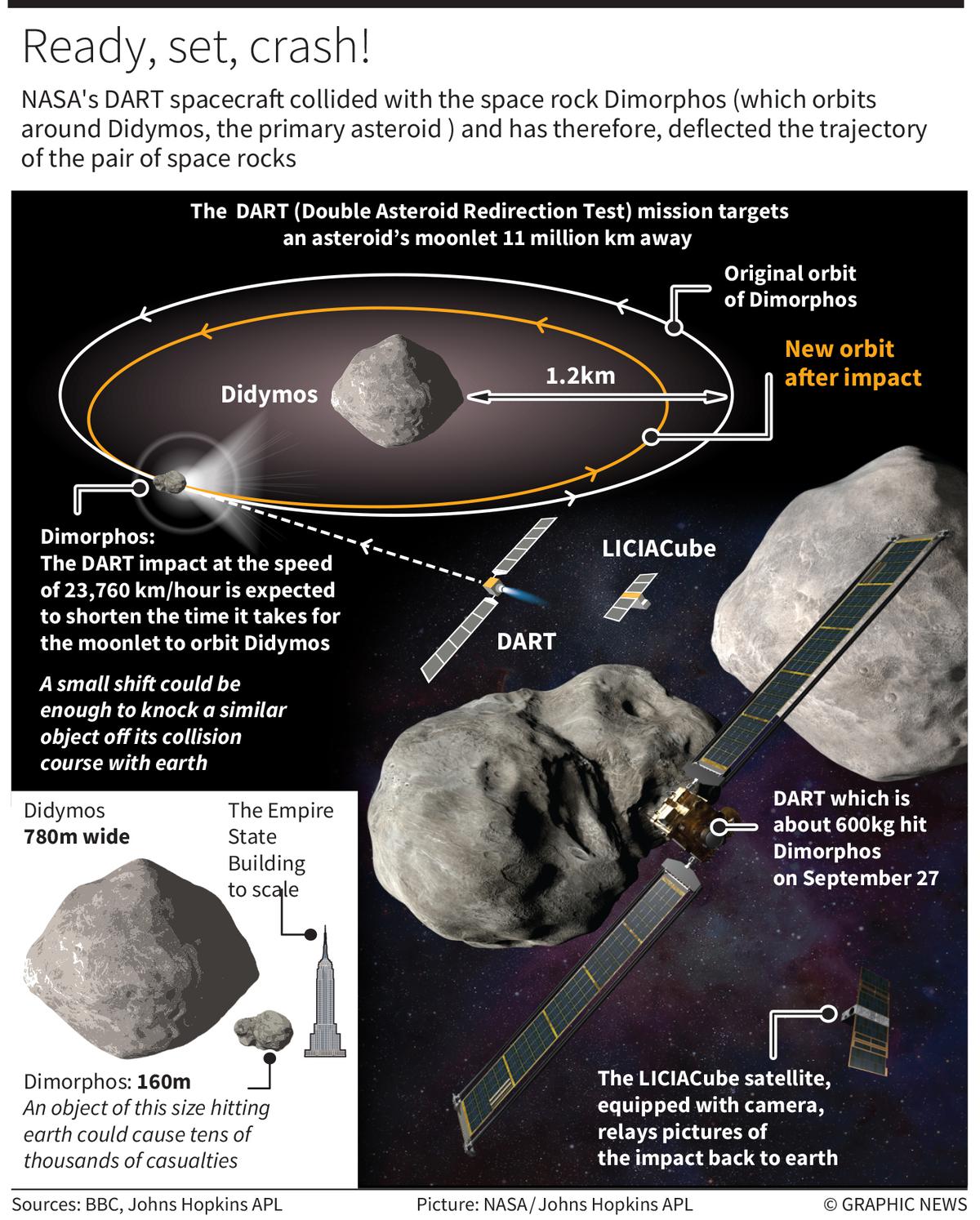Article Title: DART Mission
28-09-2022
Science & Technology Current Affairs Analysis
What’s in News?
The NASA’s DART spacecraft successfully crashed into the asteroid Dimorphos.
Double Asteroid Redirection Test (DART):
- DART was the first-ever mission dedicated to investigating and demonstrating one method of asteroid deflection by changing an asteroid’s motion in space through kinetic impact.
- It was launched in November 2021
- DART is a joint project between NASA and the Johns Hopkins Applied Physics Laboratory (APL), Maryland, US.
- International partners include the European Space Agency (ESA), the Italian Space Agency (ASI), and the Japan Aerospace Exploration Agency (JAXA), contributing to related or subsequent projects.
News Highlights:
- NASA’s Double Asteroid Redirection Test (DART) – the world’s first planetary defense technology demonstration – successfully impacted its asteroid target
- DART targeted the asteroid moonlet Dimorphos, a small body just 530 feet (160 meters) in diameter.
- It orbits a larger, 2,560-foot (780-meter) asteroid called Didymos.
- Neither asteroid poses a threat to Earth.
- The mission’s one-way trip confirmed NASA can successfully navigate a spacecraft to intentionally collide with an asteroid to deflect it, a technique known as kinetic impact.
- This method of kinetic impact is also known as the 'kick'
- DART’s CubeSat companion Light Italian CubeSat for Imaging of Asteroids (LICIACube), provided by the Italian Space Agency was deployed from the spacecraft to capture images of DART’s impact and of the asteroid’s resulting cloud of ejected matter.
Significance:
(i) Saving the Earth
- This is considered to be the first step for the world in the direction of acquiring the capability to deflect any gigantic projectile hurtling toward planet earth
- This help us to alleviate the impact events such as the massive Chicxulub asteroid impact that is credited with the extinction of the dinosaurs 65 million years ago.
- NASA has found about 40% of the large asteroids as wide as 500 feet (140 meters) that could pose a threat to the Earth and regularly scans the sky for more.
- Early detection of near-Earth asteroids is the first step in planetary defense.
(ii) Space Mining
- The ‘kick’ technique that deflects asteroids can then be used to move a small asteroid into a convenient position for space mining.
- For developing green energy technologies — electric vehicles, solar panels, wind turbines, and energy storage devices – and ushering in the low carbon economy of the future, rare earth elements such as yttrium, niobium, rhodium, palladium, osmium, iridium and scandium are critical.
- They are short in supply, and asteroid mining, it is believed, could solve the rare earth supply problem.
Way Forward:
- NASA is also developing a new space telescope sentinel called the Near-Earth Object Surveyor specifically designed to seek out hazardous asteroids in the solar system.
- That mission could launch by 2026.
- The European Space Agency (ESA) is planning a post-impact investigation mission called Hera.
- The spacecraft is planned to launch in October 2024 and reach the Didymos binary system in December 2026.
- At the heels of NASA, China is set to deflect a 40m diametre earth-crossing asteroid called 2020 PN1 sometime in 2026.

 "UPSC-2026-PRELIMS COMBINED MAINS FOUNDATION PROGRAMME" STARTS WITH ORIENTATION ON FEB-10
"UPSC-2026-PRELIMS COMBINED MAINS FOUNDATION PROGRAMME" STARTS WITH ORIENTATION ON FEB-10